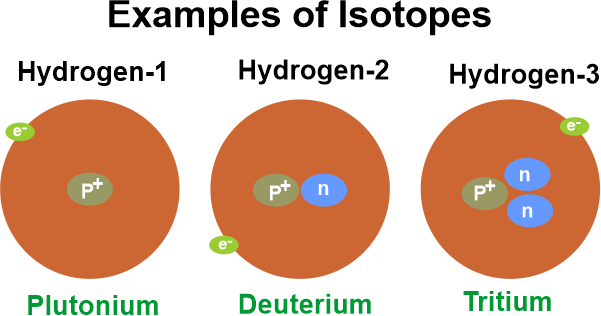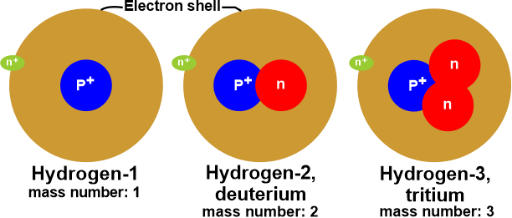Isotope DefinitionA family is frequently made up of members who are related but not identical. Isotopes, a family name for elements, also exist. Isotopes are representatives of the same element's family but have variable numbers of neutrons despite having the same number of protons. The atomic number of an element on the periodic table is determined by the number of protons in its nucleus. For instance, the atomic number 6 of carbon has six protons. Three isotopes of carbon are found in nature: carbon 13, which has 7 neutrons, carbon 14, which has 8 neutrons, and carbon 12, which has 6 neutrons (plus 6 protons = 12). There are several isotopes for each element. Even one neutron can significantly alter an isotope's characteristics. Since carbon-12 never experiences radioactive decay, it is stable. With a radioactive decay half-life of carbon-14 is unstable (meaning that half of the material will be gone after 5,730 years). Because of this decay, a procedure known as "carbon dating" may determine an object's age by measuring the quantity of carbon-14 present. Isotopes have special qualities that make them valuable in applications for diagnosis and therapy. They are crucial for national security, fundamental research, gas and oil exploration, and nuclear medicine. Facts about isotopes
Isotopes are two or more atom types that share the same atomic number (number of protons in their nuclei), location in the periodic table, and chemical element, but differ in nucleon numbers (mass numbers) because they contain varying quantities of neutrons in their nuclei. Although the chemical properties of each isotope of a particular element are almost identical, they differ in their atomic weights and physical characteristics. The name "isotope" refers to the fact that various isotopes of a single element occupy the same location on the periodic table. The term "isotope" is derived from the Greek words isos ("equal") and topos, meaning "the same place." 
In 1913, Scottish physician and author Margaret Todd suggested the term to British chemist Frederick Soddy. The atomic number of an atom is the sum of the number of protons in the nucleus and the number of particles in a neutral (non-ionized) atom. Each atomic number designates a particular element, but not an isotope; the number of neutrons in an atom of a given element can vary widely. Each isotope of an element has a particular mass number, which is based on the number of nucleons (including protons and neutrons) in the nucleus. For instance, the carbon element has three isotopes: carbon-12, carbon-13, and carbon-14, with corresponding masses of 12, 13, and 14. Since carbon has an atomic number of 6, each carbon atom contains 6 protons, resulting in isotopes with neutron numbers of 6, 7, and 8 accordingly. The quantity of protons, neutrons, and electrons that each element has makes it unique. Each chemical element's atoms have the same number of protons and electrons, which is important because neutrons' quantities are variable. Isotopes are atoms that have the same number of protons but differing numbers of neutrons. They differ in mass, which affects their physical characteristics even if they have almost identical chemical properties. There are volatile isotopes that release radiation as well as stable isotopes that do not. These are referred to as radioisotopes. The numbers and ratios of isotopes in the matter are measured using nuclear methods and using this data, their origin, history, and sources are traced. These measures assist specialists in understanding a variety of topics, including aquatic and terrestrial systems, the number of certain vitamins taken by the body, and the quantity of fertilizer plants absorb. Isotopic signatureThe ratios between the amounts of the different isotopes of an element present in a sample make up an isotopic signature. Due to their resemblance to fingerprints and their usage in tracking and tracing, isotopic signatures are often referred to as fingerprints. Water, soil, plants, and animals all contain them. These fingerprints can be followed by scientists to assess:
Persistent isotopesStable isotopes exist for the initial 80 elements in the periodic table. Stable isotopes can be utilized to comprehend and regulate water and land resources because of their unique features. They are also employed in forensics, dietary evaluations, and environmental research. Measurements of the numbers and ratios of naturally occurring stable isotopes, such as hydrogen isotopes, in water samples, are used to ascertain the age and provenance of the water, comprehend its history, and acknowledge its origins. It's called isotope hydrology. It is possible to research the land, people, animals, insects, and plants using stable isotopes. For instance, isotopes are used to track butterfly migratory routes and assist in safeguarding the resources in its breeding grounds. They may also be utilized in farming. The nitrogen-15 (N15) stable isotope is used by scientists to identify bio-nitrogen fertilizers, which allow them to monitor and evaluate how well crops absorb the fertilizer. This is significant because plants must absorb nitrogen for it to be converted into essential proteins. Scientists can calculate the amount of fertilizer required for crops to produce their highest yield by using N15. RadioisotopesMore than 3000 radioisotopes are known. They are an element's unstable form. They emit various degrees of radiation, which renders them valuable in biological investigations, industry, farming, radiopharmaceutical sciences, and industrial uses. In nuclear reactions and accelerators, radioisotopes are intentionally and safely created. Radioisotope treatment, which safely and effectively eliminates malignant cells, is one way that radioisotopes are used to treat cancer and other chronic illnesses. Other applications include improving healthcare goods by eliminating or neutralizing toxins, microorganisms, and chemicals that pose risks. Different isotopes

Facts about element isotopesHere are some fascinating isotope-related facts:
Isotopes' physical and chemical characteristicsWhen discussing an element's isotopes' chemical characteristics, they are almost equal or the same. Isotopes behave chemically in many the same ways. However, there are differences among isotopes when it comes to their physical characteristics, such as their mass, melting or boiling temperature, density, and freezing point. The mass of each isotope has a significant impact on its physical characteristics. We can identify different isotopes thanks to the periodic table.
Next TopicLight Definition
|
 For Videos Join Our Youtube Channel: Join Now
For Videos Join Our Youtube Channel: Join Now
Feedback
- Send your Feedback to [email protected]
Help Others, Please Share









